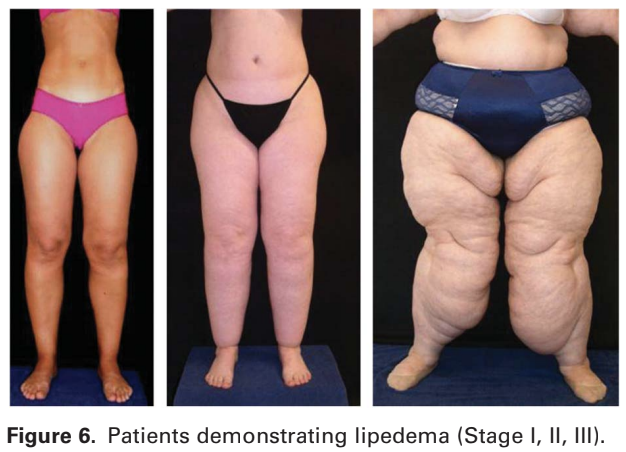Adipose tissue is made up of adipose cells and vessels and fibrous connective tissue. This is commonly referred to as “fat,” which is an essential feature in the human body, working to both cushion bones and joints as well as provide important insulation. Fat cells, at their most basic, are loose connective tissues made up of adipocytes which are charged with the responsibility of storing energy for the body to use when needed. In healthy individuals, the concentration of fat cells throughout the body is relatively balanced and directly correlates to diet, exercise, and sustainable energy requirements. However, in those individuals suffering from the condition known as Lipedema, fat cells begin to accumulate excessively in the body.
While the development of Lipedema is relatively common, it is no less considered a significantly painful condition with fat accumulations focused along the legs, thighs, and hips, and even moving into the upper torso and arms over time. Some estimates place around 80% of reported Lipedema patients suffering from disproportionate fat nodules developing in the components and lower extremities.
Lipedema and Women
The condition known today as Lipedema was first noticed and categorized in the early 1940s. Since that time, significant time has been spent studying and researching the disease better to understand its symptoms, impact, and potential cure. It is widely accepted that Lipedema primarily affects females, and some experts put the best estimate worldwide of women affected by this condition at 11%( Foldi). However, estimates range from 5% to 26% (*Raprich, Herbst). While diet and exercise are often initially recommended to women who see their primary care physicians for symptoms related to Lipedema, it quickly becomes apparent that those suffering from this disease will not see any noticeable improvements based on these factors alone.
It’s widespread for women with Lipedema to be initially misdiagnosed as obese. Similarly, many women with Lipedema are initially misdiagnosed as suffering from Lymphedema, which is more closely related to symptoms associated with damaged lymph nodes in the body. While a clear cause for Lipedema has not been established, links have been made between the condition and significant hormonal changes, including during pregnancy, childbirth, and menopause.
Recognizing Lipedema
Over time, a series of identifiable signs and symptoms associated with the development of Lipedema have become more easily recognized. In general, this condition is correlated to excessive and extremely disproportionate nodular fat cells and masses showing up across the thighs, hips, legs, upper torso, and arms. Where conditions such as Lymphedema tend to be more noticeable in one limb than the other, Lipedema affects both legs and arms equally in patients. Many individuals suffering from Lipedema are prone to bruising and report a significant amount of pain associated with cell buildup and swelling.
Stages of Lipedema
While Lipedema targets women, it does not develop in the same way every time. It can be recognized in three distinct stages. Stage 1 includes the appearance of smooth skin over pearl-sized fat cells. Stage 2 presents as a collection of skin indentations over masses that range in size from those similar to a pearl to those similar in dimension to an apple. Individuals with Stage 3 Lipedema suffer from pearl-sized nodules that exist in combination with large fat masses and lobules that overlap along the legs and up into the arms.


Recent Studies
To better understand the physiological processes that define Lipedema, a recent study looking at biopsy samples of thigh skin and fat was carried out. The histology of these samples was analyzed to determine significant changes in lymphatic vessel size, cell fluctuations, and anomalies related to surrounding tissues in those that suffer from Lipedema. The study also looked at the potential for Lipedema to be linked to obesity. 49 participants were involved in the study and were divided into obese and non-obese based on body mass index. 30 of these participants had Lipedema while 19 were analyzed as control groups.
Research Conclusions
Using precision imaging software, the samples were analyzed, and the results showed significant changes in fat cell dimensions among those non-obese participants as compared to their control group. These dimensions were similar to those presented in the obese category.
Macrophage numbers, which are increased at sites of infection, were also significantly increased among non-obese and obese samples compared to their non-Lipedema counterparts. Similarly, dermal vessels were increased among non-obese participants compared to controls. In contrast, areas of increased blood vessels were found in 30% of participants with Lipedema disease compared to 0% in control groups. The cumulation of this information leads experts in the field to believe that increased macrophages, dilated capillaries, and blood vessels in thigh tissue and fat can be equally present in non-obese and obese women suffering from Lipedema. This lends itself to the idea that an altered vasculature in an individual could potentially be a more significant determinant in disease manifestation than weight.
Buck Herbst (1)Clodius, L. M. Földi, E. Földi, S. Kubik (Eds.): Textbook of Lymphology (in German), 6th edn. Elsevier, Munich, 2005, 768 pp. ISBN 3-437-45322-X, US$ 95.00. Eur J Plast Surg 28, 537–538 (2006). https://doi.org/10.1007/s00238-005-0024-z







